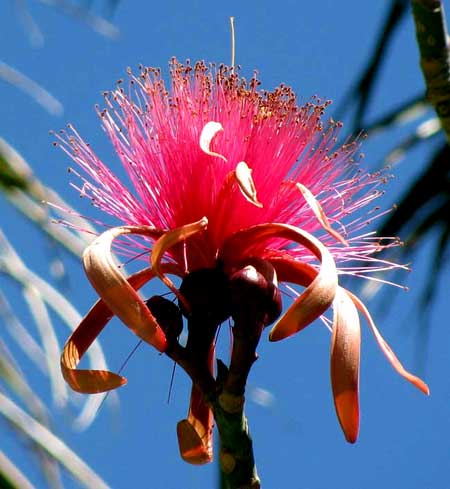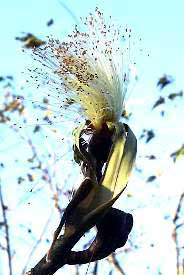
During the dry season sometimes you see medium-sized trees with thick, pale gray, semisucculent, gangly branches at the tips of which arise four-inch-high (10cm) flowers like the one shown below.

 That's a single flower, and flowers can be either pink or white; a white one is shown at the right. The tree producing these gorgeous flowers is sometimes called Shavingbrush Tree. It's Pseudobombax ellipticum, a member of the Hibiscus Family, the Malvaceae.
That's a single flower, and flowers can be either pink or white; a white one is shown at the right. The tree producing these gorgeous flowers is sometimes called Shavingbrush Tree. It's Pseudobombax ellipticum, a member of the Hibiscus Family, the Malvaceae.
Right before they open, Shavingbrush Tree's flower buds look like four-inch-long (10cm), brown cigars. The brownness is on the outside of long petals slightly connected to one another along their margins. When the long bud is about to open, usually just after dawn, first the connected petals buckle outward at their bases making slits.
That's when birds such as Hooded Orioles come, stick their bills through the vertical slits, and sip nectar. There must be a lot of nectar, too, for sometimes the birds' throat muscles vigorously work as they sip, and glistening beads of nectar cling to the birds' withdrawn beaks. Also, the nectar-feeding birds pee as frequently as sapsuckers at sap-rising time up North.
As the morning warms, the blossoms open, attracting not only birds but also honeybees. It's nothing to see a yellow and black oriole probing deeply into the stamen tuft while six to ten bees work the same flower's stamen tips. Pretty!
During the rainy season Shavingbrush Tree is green with digitally compound leaves -- the leaflets arising from the leaf petioles' tops like digits from hands. The fruits look like large okra pods filled with pea-sized seeds and white fuzz. When still green, before the fuzz has become dry and the seeds hard, the pods' contents can be eaten. In Maximino Martinez's Las Plantas Medicinales de México it's reported that the flowers can be cooked to make a tea for fevers and coughs, and powdered bark from the tree can tighten gums.
This magnificent species is native to our area -- southern Mexico south to Honduras and El Salvador, and is grown as an ornamental in Florida, Hawaii and other semitropical parts of the world. It can reach 60 feet high (18m).